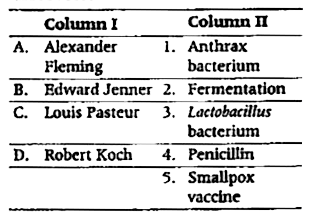In Column I, names of eminent scientists have been given while in Column II work related to them has been mentioned. Match the columns correctly.
Column IColumn II(a) Leeuwenhoek(i) Bacteria(b) Robert Brown(ii) Cell(c) Robert Hooke(iii) Nucleus(d) Purkinje(iv) Electron microscope(e) Knoll and Ruska(v) Protoplasm
(a)–(i), (b)(iii), (c)-(ii), (d)-(iv), (e)-(v)
(a)–(i), (b)-(iii), (c)—(ii), (d)—(v), (e)—(iv)
(a)–(iv), (b)–(ii), (c)–(i), (d)—(v), (e)-(iii)
(a)–(i), (b)–(ii), (c)–(iii), (d)–(iv), (e)-(v)
The correct Answer is:B
To match the scientists in Column I with their respective works in Column II, we will analyze each scientist and their contributions step by step.
1. (a) Leeuwenhoek:
- Leeuwenhoek is known for his discovery of bacteria. He was the first to observe and describe these microorganisms using a microscope he developed.
- Match: (a) Leeuwenhoek → (i) Bacteria
2. (b) Robert Brown:
- Robert Brown is famous for discovering the nucleus within plant cells. He observed this structure while studying orchids.
- Match: (b) Robert Brown → (iii) Nucleus
3. (c) Robert Hooke:
- Robert Hooke is credited with the discovery of the cell. He coined the term "cell" after observing cork cells under a microscope.
- Match: (c) Robert Hooke → (ii) Cell
4. (d) Purkinje:
- J.E. Purkinje is known for coining the term "protoplasm," which refers to the living substance within a cell.
- Match: (d) Purkinje → (v) Protoplasm
5. (e) Knoll and Ruska:
- Knoll and Ruska are recognized for their invention of the electron microscope, which allowed for much higher resolution imaging of cells and their components.
- Match: (e) Knoll and Ruska → (iv) Electron microscope
Final Matching:
- (a) Leeuwenhoek → (i) Bacteria
- (b) Robert Brown → (iii) Nucleus
- (c) Robert Hooke → (ii) Cell
- (d) Purkinje → (v) Protoplasm
- (e) Knoll and Ruska → (iv) Electron microscope
- Leeuwenhoek is known for his discovery of bacteria. He was the first to observe and describe these microorganisms using a microscope he developed.
- Match: (a) Leeuwenhoek → (i) Bacteria
- Robert Brown is famous for discovering the nucleus within plant cells. He observed this structure while studying orchids.
- Match: (b) Robert Brown → (iii) Nucleus
- Robert Hooke is credited with the discovery of the cell. He coined the term "cell" after observing cork cells under a microscope.
- Match: (c) Robert Hooke → (ii) Cell
- J.E. Purkinje is known for coining the term "protoplasm," which refers to the living substance within a cell.
- Match: (d) Purkinje → (v) Protoplasm
- Knoll and Ruska are recognized for their invention of the electron microscope, which allowed for much higher resolution imaging of cells and their components.
- Match: (e) Knoll and Ruska → (iv) Electron microscope
- (a) Leeuwenhoek → (i) Bacteria
- (b) Robert Brown → (iii) Nucleus
- (c) Robert Hooke → (ii) Cell
- (d) Purkinje → (v) Protoplasm
- (e) Knoll and Ruska → (iv) Electron microscope
Topper's Solved these Questions
- CEL: THE BASIC UNIT OF LIFEBOOK - CENGAGE BIOLOGYCHAPTER - CEL: THE BASIC UNIT OF LIFEEXERCISE - CHALLENGING EXERCISE
4 Videos
- CEL: THE BASIC UNIT OF LIFEBOOK - CENGAGE BIOLOGYCHAPTER - CEL: THE BASIC UNIT OF LIFEEXERCISE - CONSOLIDATED EXERCISE (Multiple Choice Questions with More Than One Correct Answer)
64 Videos
- BIOLOGICAL CLASSIFICATION BOOK - CENGAGE BIOLOGYCHAPTER - BIOLOGICAL CLASSIFICATION EXERCISE - CHALLENGING EXERCISE
1 Videos
- CELL CYCLE AND CELL DIVISION BOOK - CENGAGE BIOLOGYCHAPTER - CELL CYCLE AND CELL DIVISION EXERCISE - CHALLENGING EXERCISE
6 Videos
Similar Questions
Match items in Column I with those in Column II:
Column IColumn II(a) Bud(i) Maple(b) Eyes(ii) Spirogyra(c ) Fragmentation(iii) Yeast(d) Wings(iv) Bread mould(e ) Spores(v) Potato(vi) Rose
View SolutionMatch the column I with Column II:-
Column IColumn II(A) Unicellular(i) Spirogyra(B) Colonial(ii) Kelps(C) Filamentous(iii) Volvox(D) massive plant bodies(iv) Chlamydomonas
View Solution
Knowledge Check
Match the column I and II
Column IColumn II(a) Apocarpous(i) Papaver(b) Syncarpous(ii) Michellia(c) Epiphyllous(iii) Cashew(d) Cotyledon(iv) AloeAa – i, b–ii, c–iii, d –ivBa – ii, b–i, c–iv, d –iiiCa – iv, b–iii, c–ii, d –iDa – iv, b–i, c–iii, d –iiMatch the column I with column II
Column IColumn II(A) Thylacine (i) Russia (B) Dodo (ii) Mauritius (c ) Quagga(iii) Australia (D) Steller's sca cow (iv) AfricaAa (ii), b (iii), c (i), d(iv)Ba(iv), b(i), c(ii), d(iii)Ca(iii), b(iv), c(ii), d(i)Da(iii), b(ii), c(iv), d(i)In Column I, names of scientists are given and in Column II, some discoveries are given.

The correct match of the names or scientists with their discoveries isAABCD4253BABCD3521CABCD4521DABCD1324
Match the compounds given in Column I with their uses mentioned in Column II.
 .
.
View SolutionMatch the items in Column I with those in Column II:
Column IColumn II(a) Yeast(i) Earthworm(b) Diaphragm(ii) Gills(c ) Skin(iii) Alcohol(d) Leaves(iv) Chest cavity(e ) Fish(v) Stomata(f) Frog(vi) Lungs and skin
View SolutionMatch the elements given in column I with the properties mentioned in Column II.

View SolutionMatch the columns
Column IColumn II(a)Echidna(i)Ophidia(b)Echinus(ii)Teleostei(c)Echeneis(iii)Platyhelminthes(d)Echis(iv)Echinoidea(e)Echinococcus(iv)Prototheria.
View SolutionMatch the column I and II
Column IColumn II(i) Chrysophyte(a) Gonyaulax(ii) Dinoflagellate(b) Euglena(iii) Euglenoids(c) Diatom(iv) Slime moulds(d) Plasmodium
View Solution
